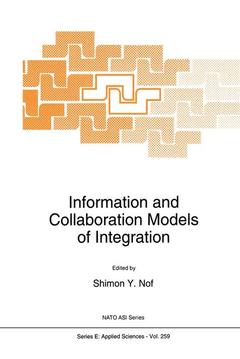Description
Information and Collaboration Models of Integration, 1994
NATO Science Series E: Series, Vol. 259
Coordinator: Nof Shimon Y.
Language: English
Subjects for Information and Collaboration Models of Integration:
Keywords
collaborative work; design; information system; modeling; software
Publication date: 10-2012
476 p. · 16x24 cm · Paperback
476 p. · 16x24 cm · Paperback
Description
/li>Contents
/li>
The objective of this book is to bring together contributions by eminent researchers from industry and academia who specialize in the currently separate study and application of the key aspects of integration. The state of knowledge on integration and collaboration models and methods is reviewed, followed by an agenda for needed research that has been generated by the participants. The book is the result of a NATO Advanced Research Workshop on "Integration: Information and Collaboration Models" that took place at II Ciocco, Italy, during June 1993. Significant developments and research projects have been occurring internationally in a major effort to integrate increasingly complex systems. On one hand, advancements in computer technology and computing theories provide better, more timely, information. On of users and clients, and the the other hand, the geographic and organizational distribution proliferation of computers and communication, lead to an explosion of information and to the demand for integration. Two important examples of interest are computer integrated manufacturing and enterprises (CIM/E) and concurrent engineering (CE). CIM/E is the collection of computer technologies such as CNC, CAD, CAM. robotics and computer integrated engineering that integrate all the enterprise activities for competitiveness and timely response to changes. Concurrent engineering is the complete life-cycle approach to engineering of products. systems. and processes including customer requirements, design. planning. costing. service and recycling. In CIM/E and in CE, computer based information is the key to integration.
• Integration and Collaboration Models.- • Planning and Control of Concurrent Engineering Activities Under Uncertainty.- • Integration of Recycling Considerations Into Product Design— A System Approach.- • Scheduling Design Activities.- • A Model-Based Methodology for Management of Concurrent Simultaneous Engineering.- • Life-Cycle Support of a New Generation of Open and Highly Configurable Manufacturing Control Systems.- • A Theoretical Model to Preserve Flexibility in FMS.- • Designing Collaborative Systems to Support Reactive Problem-Solving in Manufacturing.- • Meta-Models for Integrating Production Management Functions in Heterogeneous Industrial Systems.- • Enterprise Integration: A Tool's Perspective.- • Architecture Consistency for CIMOSA Implementation.- • Cooperation Requirement Planning for Multiprocessors.- • Benchmarking and Models of Integration.- • Issues in Enterprise Modeling.- • Information and Collaboration from a Social/Organizational Perspective.- • Professional Work, Cooperative Work, Meeting Software: A Practical View.- • CM3, Looking into the Third and Fourth Dimensions of GDSS.- • Pictorial and Text Editors for the Collaborative Work Environment.- • Neural Network Based Agents for Coordination of Interaction.- • New Approaches to Multi-Agent Planning.- • Modeling and Prototyping Collaborative Software Processes.- • Blackboard Based Coordination in Cooperative Problem Solving.- • A Generic Architecture with Neutral Interfaces Off-Line Robot Programming and Simulation.- • Integrated Support for Cooperative Design Coordination: Managing Processes, Conflicts and Memories.- Panel Reports.
© 2024 LAVOISIER S.A.S.




